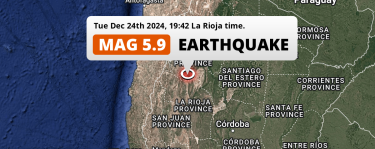Latest earthquakes near Chile today
Complete overview of the latest earthquakes near the country Chile, updated every minute. Did you feel an earthquake today in Chile? If an earthquake is happening right now near Chile, it will show up within minutes.
Recent Chile Earthquake News
These are the latest articles published related to earthquakes occurring near Chile. Check our Earthquake News section for a complete overview of articles written on earthquakes near Chile and elsewhere.
Chile Earthquake Statistics
Average
A total of 10257 earthquakes with a magnitude of four or above have struck within 300 km (186 mi) of Chile in the past 10 years. This comes down to a yearly average of 1025 earthquakes per year, or 85 per month. On average an earthquake will hit near Chile roughly every 8 hours.
A relatively large number of earthquakes occurred near Chile in 2015. A total of 1851 earthquakes (mag 4+) were detected within 300 km of Chile that year. The strongest had a 8.3 magnitude.

Magnitude Distribution
The table below visualizes the distribution of all earthquakes that occurred within 300km of Chile in the past 10 years. No earthquakes with a magnitude of 9 or above have occurred near Chile during this time. Usually, higher magnitudes are less common than lower magnitudes. Small earthquakes with a magnitude below 4 on the Richter scale have been omitted from this overview.
| Magnitude | Earthquakes | Percentage |
|---|---|---|
| Mag. 4 | 9568 | 93.28% |
| Mag. 5 | 607 | 5.92% |
| Mag. 6 | 78 | 0.76% |
| Mag. 7 | 3 | 0.03% |
| Mag. 8 | 1 | 0.01% |
| Mag. 9 | 0 | 0.0% |
| Mag. 10 | 0 | 0.0% |
Strongest earthquakes near Chile
The strongest recent earthquake of the past 10 years near Chile occurred on Sep 16, 2015 19:54 local time (America/Santiago timezone). It had a magnitude of 8.3 and struck 48 kilometers (30 mi) west of Illapel, at a depth of 22 km. Discover more strong earthquakes near Chile in the list below.
A longer time ago, a MAG-9.5 earthquake struck on May 22, 1960 15:11, 97 kilometers (60 mi) west of Temuco. It is the strongest earthquake near Chile in the past 125 years (Our data goes back to January 1st, 1900).
In the table below you will find the strongest earthquakes that occurred near Chile in the past 10 years. You can use the tabs to find the heaviest historic earthquakes since the year 1900 or within a specific year or distance from Chile.
Earthquakes by region of Chile
Click the links below for earthquake reports for regions in Chile.
- Antofagasta
- Araucanía
- Arica y Parinacota
- Atacama
- Aysén
- Biobío
- Coquimbo Region (Coquimbo)
- Los Lagos Region (Los Lagos)
- Los Ríos Region (Los Ríos)
- Magallanes
- Maule Region (Maule)
- O'Higgins Region (O'Higgins)
- Santiago Metropolitan (Metropolitana)
- Tarapacá
- Valparaíso
- Ñuble
Frequently Asked Questions
These questions are commonly asked in relation to earthquakes occurring near Chile.
When was the last earthquake in Chile?
A 2.7 magnitude earthquake hit near Chile on the night of January 15, 2025 at 03:19 local time (America/Santiago). The center of this earthquake was located 32km north-northwest of Chillán at a depth of 56km under land. Check the list on our website for any earthquakes occurring near Chile in the past hours.
What was the strongest earthquake near Chile?
A 9.5 magnitude earthquake hit near Chile on the afternoon of May 22, 1960 at 15:11 local time (America/Santiago). The center of this earthquake was located 97km northwest of Temuco at a depth of 25km under land. This is the strongest earthquake that occurred near Chile since the year 1900.
How often do earthquakes occur near Chile?
In the past 10 years, 10257 earthquakes with a magnitude of four or higher occurred within a 300 kilometer range from Chile. This averages to 1026 earthquakes yearly, or one earthquake every 9 hours.

 Jan 2, 2025 05:43PM
On Thursday Afternoon a Strong M6.1 Earthquake struck near Calama in Chile.
Jan 2, 2025 05:43PM
On Thursday Afternoon a Strong M6.1 Earthquake struck near Calama in Chile.
 Dec 31, 2024 08:13PM
Significant M5.1 Earthquake hit in the South Pacific Ocean near Iquique (Chile) on Tuesday Evening.
Dec 31, 2024 08:13PM
Significant M5.1 Earthquake hit in the South Pacific Ocean near Iquique (Chile) on Tuesday Evening.
 Dec 30, 2024 02:41AM
On Monday Night a Shallow M5.5 AFTERSHOCK struck in the South Pacific Ocean near Coquimbo (Chile).
Dec 30, 2024 02:41AM
On Monday Night a Shallow M5.5 AFTERSHOCK struck in the South Pacific Ocean near Coquimbo (Chile).
 Dec 30, 2024 02:40AM
On Monday Night a Shallow M5.5 Earthquake struck in the South Pacific Ocean near Coquimbo (Chile).
Dec 30, 2024 02:40AM
On Monday Night a Shallow M5.5 Earthquake struck in the South Pacific Ocean near Coquimbo (Chile).
 Dec 24, 2024 07:42PM
On Tuesday Evening an Unusually powerful M5.9 Earthquake struck 142km from La Rioja in Argentina.
Dec 24, 2024 07:42PM
On Tuesday Evening an Unusually powerful M5.9 Earthquake struck 142km from La Rioja in Argentina.
 Dec 18, 2024 01:09AM
On Wednesday Night a Significant M5.2 Earthquake struck near Iquique in Chile.
Dec 18, 2024 01:09AM
On Wednesday Night a Significant M5.2 Earthquake struck near Iquique in Chile.
